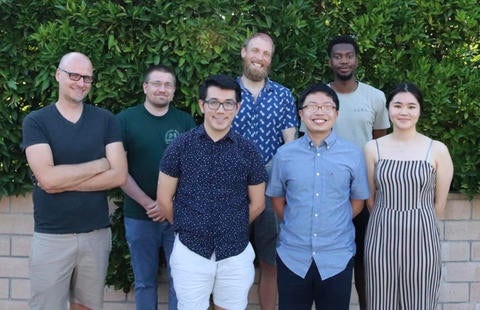How Specificity Of The Brain Is Wired
UC Riverside mouse study identifies key molecules that determine specificity of neural circuits
Neurons, which communicate with each other via specialized connections called synapses, convey information between different brain regions, as well as between the brain and the rest of the nervous system.
 Garret Anderson. (UCR/Anderson lab)
Garret Anderson. (UCR/Anderson lab)
A University of California, Riverside, research team has identified cell-adhesion molecules, called latrophilin-2, that help neurons connect at synaptic sites. The researchers identified enrichment of these molecules in a region of the mouse brain called the entorhinal cortex, which lies adjacent to the hippocampus. Like the hippocampus, the entorhinal cortex is important for learning and memory processes.
“These cell-adhesion molecules determine the specificity of neural circuits,” said Garret R. Anderson, an assistant professor of molecular, cell and systems biology, who led the study appearing in Cell Reports. “Without such specificity, neuronal connections in the brain would be haphazard and the nervous system wouldn’t work the way it does.”
Anderson explained that when neurons connect with each other at synaptic sites, the connection is essentially a recognition process between the neurons, with latrophilin-2 serving as a key molecule in driving this process.
“There is specificity in terms of how neurons project to multiple brain regions and connect with each other,” he said. “Latrophillin-2 is important for this recognition process. The molecule is only expressed by select neurons, and further, is positioned only at a subset of synapses that a neuron receives. In the entorhinal cortex, we found some very interesting expression patterning of latrophilin-2, which is the focus of our study.”
Anderson’s lab is focused on understanding what makes two neurons connect with each other, which could allow for the design of new neuronal connections that could have therapeutic implications for neurodegenerative diseases.
 Garret Anderson (left) and his research group. Back row, left to right: Thomas Murphy, Jordan Donohue, and Moyinoluwa Ajayi; front row, left to right: Alexander King, Anthony Wong, and Elizabeth Liu. (UCR/Anderson lab)
Garret Anderson (left) and his research group. Back row, left to right: Thomas Murphy, Jordan Donohue, and Moyinoluwa Ajayi; front row, left to right: Alexander King, Anthony Wong, and Elizabeth Liu. (UCR/Anderson lab)
“If you are going to fix a car, you’re going to have to know how it is built,” Anderson said. “Similarly, to understand diseases such as Alzheimer’s, where there is memory degradation, we have to understand how brain circuits are built in the first place. This study takes an important first step in this regard by identifying the molecules controlling the circuit and how it is built.”
The study, funded by a grant to Anderson from the Whitehall Foundation, has relevance for humans. Three different latrophilin genes in mice are conserved in humans.
Anderson was joined in the study by lead researcher Jordan D. Donohue, a student in the UCR Neuroscience Graduate Program; and assisted by Ryan F. Amidon, Thomas R. Murphy, Anthony J. Wong, Elizabeth D. Liu, Lisette Saab, Alexander King, Haneal Pae, and Moyinoluwa T. Ajayi.
The research paper is titled “Parahippocampal Latrophilin-2 (ADGRL2) expression controls topographical presubiculum to entorhinal cortex circuit connectivity.”
Publication: Jordan D. Donohue, et al., Parahippocampal latrophilin-2 (ADGRL2) expression controls topographical presubiculum to entorhinal cortex circuit connectivity, Cell Reports (2023). DOI: 10.1016/j.celrep.2021.110031
Original Story Source: University of California – Riverside

 Alerts Sign-up
Alerts Sign-up